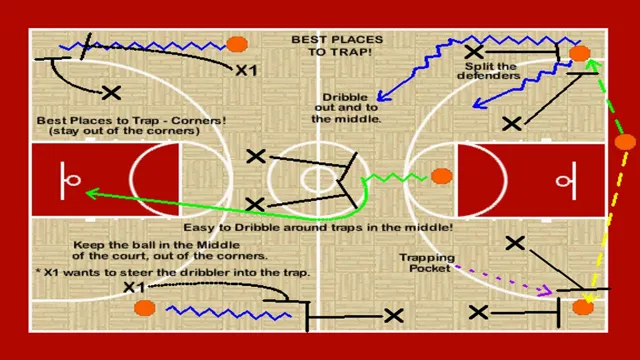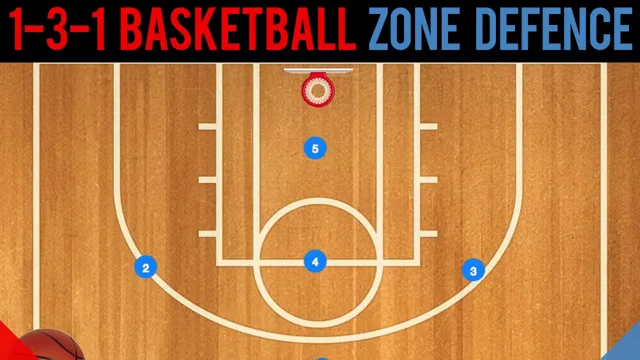As a basketball player, mastering basketball trapping is quintessential. Almost every team uses this move to gain possession of the ball or to create a turnover. Trapping is also an effective way of disrupting an opponent’s offensive flow.
It involves using two or more players to converge on the ball handler and limit their passing and shooting options. Sounds easy right? Well, it can be if you have the right skills and techniques. In this blog, we will delve into the basics of basketball trapping, the different types, and how you can become a trapping pro.
So, buckle up, and let’s dive into this exciting world of basketball trapping.
What is Basketball Trapping?
Basketball trapping is a defensive tactic used to disrupt the opposing team’s offensive flow by quickly double-teaming a ball handler. Essentially, the trapping technique involves two defenders converging on one offensive player. The main objective of the trap is to force the player with the ball to pass it away or potentially turn it over – a strategy that can shift the momentum of the game.
Trapping involves excellent coordination among the defenders, strong communication, and quick reflexes. It may be executed by trapping the player in the corner, at the sideline, or even in the backcourt. Though effective, trapping may also leave a team vulnerable to an offensive counter-attack if not executed correctly.
As such, teams that specialize in trapping typically have quick and agile players and practice the technique extensively. In short, basketball trapping is a tactical defensive technique that can be highly effective if executed correctly and used wisely.
Understanding the Concept of Trapping in Basketball
Basketball trapping is a defensive strategy used to limit an opponent’s offensive moves. It involves double-teaming the player in possession of the ball to make them feel pressured and to force them to make a mistake or pass the ball away. This technique relies on the defenders’ ability to move quickly and anticipate the next move of the opposing team.
Trapping can be done in various locations on the court, such as near the sidelines, the corners, or even in the half-court. While trapping can be an effective technique, it can also be risky, as it leaves other offensive players free to move and shoot. Therefore, it requires a balance between aggression and control to be successful.
Overall, basketball trapping is a valuable tool for teams looking to gain an edge in their defense, and it requires proper execution and teamwork to be effective on the court.

Different Types of Trapping Techniques
Basketball trapping is a defensive strategy used in the game of basketball. Essentially, trapping is when two or more defenders work together to try to steal the ball from the offensive player. This can happen anywhere on the court and can be initiated by the defense at any time.
The purpose of trapping is to force the offensive player into a bad pass or a turnover. It can also be used to slow down the game and disrupt the offense’s rhythm. There are different types of trapping techniques, including full-court press, half-court trap, and zone trap.
Each of these techniques requires different defensive positioning and communication between defenders. A successful trap requires quick reactions, good communication, and a coordinated effort from the defense. Players who can read the offense well and anticipate their moves are best suited for trapping.
Overall, basketball trapping is an effective defensive strategy when executed correctly.
The Importance of Basketball Trapping
Basketball trapping is one of the most crucial defensive strategies that can help a team to win games. It involves strategically placing two or more defenders to surround the ball handler, forcing them to make a mistake and turn the ball over. This tactic can be highly effective when executed correctly, as it puts immense pressure on the opposing team to make quick and smart decisions.
However, basketball trapping requires a great deal of skill and coordination from the defenders, who must work together seamlessly to create an impenetrable wall around the ball. With proper practice and execution, basketball trapping can help a team to take control of the game, shut down their opponents, and ultimately achieve success on the court.
Winning More Possessions
Basketball trapping is an integral part of a team’s strategy to win more possessions during the game. Trapping is essentially blocking the opponent’s pass or dribbling options by crowding them with two or more defenders. It not only reduces the passing options that the opposing team has but also increases the chances of turnovers, leading to more scoring opportunities in transition.
A good trap requires coordination and communication between the defenders, and it can catch even the best of players off guard. Additionally, trapping can disrupt the offensive rhythm of the opposing team, forcing them into making hasty decisions, which can be capitalized on by the defense. Therefore, mastering basketball trapping is key to securing more victories and dominating the game.
A Strong Defensive Strategy
Basketball teams that rely on a strong defensive strategy understand the importance of trapping. Trapping refers to a technique where two defenders work together to quickly close off passing lanes and create turnovers. It is an essential part of any team’s defensive tactics, as it allows them to disrupt the opposing team’s offense and gain possession of the ball.
Trapping is also an effective way to build momentum and create scoring opportunities. By trapping the ball handler and forcing a turnover, teams can quickly transition from defense to offense and score before their opponents have time to recover. However, trapping requires careful coordination and communication between the defenders, as well as quick reflexes and agility.
With practice, teams can develop a strong trapping game that can make the difference between a win and a loss.
Psychological Impact on Opponents
Basketball trapping can have a considerable psychological impact on opponents, making it an essential skill in the game. Trapping can create a feeling of panic and confusion for the opposing team, causing them to lose focus and make mistakes. By quickly closing off the passing lanes, trapping can increase the chance of turnovers and steal opportunities.
Additionally, trapping can force the opposing team to take rushed and low-percentage shots, leading to a decrease in shooting efficiency. Moreover, the psychological impact of trapping can lead to frustration, which can effectively disrupt the flow of the opposing team’s offense. Therefore, mastering basketball trapping should be a top priority for every basketball player, as it can significantly impact the outcome of the game.
Tips for Effective Basketball Trapping
Basketball trapping is an effective defensive strategy that can help your team gain an advantage over the opposition. It involves surrounding the ball-handler with two or more defenders in an attempt to force a turnover or a bad pass. However, it’s important to execute the trap correctly to avoid giving up an easy basket.
One key tip is to communicate effectively with your teammates to ensure everyone is on the same page and knows their role in the trap. Additionally, timing is crucial, so it’s important to anticipate the ball-handler’s movements and act quickly. It’s also important to maintain active hands and footwork to prevent the ball-handler from passing or dribbling out of the trap.
Lastly, remember to stay disciplined and avoid fouling the ball-handler. With these tips in mind, you can become a more effective basketball trapping team and give your defense an edge on the court.
Quick Communication is Key
Effective Basketball Trapping Quick communication is essential when it comes to successful basketball trapping. Trapping is a defensive strategy in which two defenders work together to surround and trap the offensive player with the ball. To execute the trap effectively, both defenders must be in sync, which requires quick communication.
One defender must signal to the other that he’s ready to trap, and the other defender must quickly slide into position to cut off the offensive player’s dribble and passing options. Clear and concise verbal cues like “trap,” “push,” and “stay” can help streamline communication and avoid confusion. Additionally, non-verbal communication like eye contact and body language can also play a crucial role in successful trapping.
By working together and communicating effectively, defenders can create turnovers and take control of the game.
Use Speed and Agility to Your Advantage
When it comes to effective basketball trapping, speed and agility are your best friends. The key is to anticipate your opponent’s moves and be ready to act quickly. One strategy is to employ a double team where two defenders work together to trap the ball handler.
However, this requires coordination and communication between teammates. Another approach is to use your quickness to close off passing lanes and force your opponent into making a mistake. This can be particularly effective in the backcourt where there is less room to maneuver.
Overall, the key to successful trapping is to stay light on your feet and be ready to react at a moment’s notice. By using your quickness and agility, you can disrupt your opponent’s offense and create opportunities for your team to score.
Mastering the Basics of Basketball Trapping
If you’re looking to improve your basketball skills, mastering the art of trapping is a crucial aspect to focus on. Essentially, it involves blocking off an opponent’s passing options, leaving them with few options other than to dribble the ball or take a shot. It can be done defensively or offensively, depending on the situation on the court.
To become proficient in trapping, it’s important to work on your footwork and coordination, as well as your anticipation skills, so you can predict where the ball and your opponent will be going. Basketball trapping requires quick reflexes and an ability to stay calm under pressure, and it can be a useful weapon in your arsenal to help your team succeed. Remember, practice makes perfect, so keep working on your trapping skills and watch your game improve.
Conclusion
In basketball, trapping is like a game of cat and mouse. The defense tries to trap the offense, while the offense tries to escape the trap. It’s a strategic dance that requires quick thinking, teamwork, and a bit of finesse.
With the right approach, basketball trapping can be an effective way to disrupt the opponent’s offense and gain momentum for your team. So, next time you find yourself in a basketball trap, remember to stay calm, stay focused, and always keep moving. Because in the end, it’s not about who gets trapped, but who escapes with the win.
“
FAQs
What is basketball trapping?
Basketball trapping is a defensive strategy where two or more defenders converge on an offensive player in an attempt to force a turnover or steal the ball.
How do players execute basketball trapping?
Players execute basketball trapping by using footwork, vision, and communication to quickly cut off the offensive player’s options and limit their passing lanes.
Is basketball trapping an effective defensive strategy?
Yes, basketball trapping can be an effective defensive strategy when executed correctly. It can disrupt the offensive flow and force turnovers, leading to scoring opportunities for the defense.
What are some common mistakes to avoid when using basketball trapping?
Common mistakes to avoid when using basketball trapping include leaving passing lanes open, failing to maintain proper positioning, and lack of communication between defenders.


